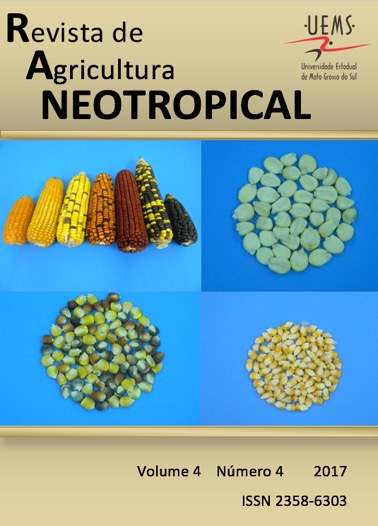COMPARISON OF DIFFERENT MEDIA TO PRODUCE CYMBIDIUM ORCHIDS BY PSEUDOBULBS
DOI:
https://doi.org/10.32404/rean.v4i4.1701Resumo
Nowadays, Orchids are one of the most commercial products in flower markets. One of the propagation methods for Cymbidium is using old pseudobulbs that are thrown out after flowering period. This research carried out using standard Cymbidium back-bulbs based on randomized complete block design with 5 treatments in 3 replications. The trial traits were leaf length, root length, leaf number and root number that were studied for 180 days. The results show that minimum length of root was significant under different growth beds. The minimum percent of rooting was observed in pure sand treatment. The maximum length was observed in pure perlite. The shortest of leaves were gained in perlite + sand treatment and the maximum leaf length was observed in pure perlite treatment. The maximum average of root percent was seen in pure perlite treatment.
Referências
(1) AGHA OGHLU, Y. S.; CELIK, H.; CELIK, M.; FIDAN, Y.; GULSEN, Y.; GUNAY, A.; HALLORAN, N.; KOKSAL, A. L; YANMAZ, R. General horticulture (in Turkish). Ankara University, Agriculture faculty. Ankara, v. 8, n. 3, p. 1044-1050. 1995.
(2) BATCHMAN, L. Cymbidium potting mixes. CSA Journal. Pasadena, v. 9, n. 5. p. 35-37. 2009.
(3) BLANCHARD, M. G.; RUNKLE, E. S. Temperature and pseudobulb size influence flowering of odontioda orchids. Hortscience. Alexandria, v. 43, n. 5, p. 1404-1409. 2008.
(4) CRIB, P.; PUY, D. The genus cymbidium. Beccles: Kew Publishing, 2007. 369 p.
(5) DRESSLER, R. L. The Orchids: natural history and classification. London: Harvard University Press, 1990. 332 p.
(6) EL-SAYED, S. F.; HASSAN, H. A.; ABUL-SOUD, M.; GAD, D. A. M. Effect of different substrates and nutrient solutions on vegetative growth, mineral content, production and quality of strawberry. Zagazig Journal of Horticultural Science. Zagazig, v. 43, n 6A, p. 1919-1938. 2016.
(7) ERGENE, A. Principle of soil science. Erzurum: Ataturk University, Agriculture Faculty, 1993. 560 p.
(8) HEW, C. S.; YONG, J. W. H. The physiology of tropical orchids in relation to the industry. Singapore: World Scientific, 2004. 370 p.
(9) HSU, J. H.; LIN, R. S. Effect of cultural medium and hydroponic culture on growth and flowering quality of Oncidium Gower Ramsey. Acta Horticulturae. Seoul, v. 761, p. 489-493. 2005.
(10) KAHRAMAN, O.; AKÇAL, A. The enlargement of leucojum Aestivum l. in different substrates under greenhouse condition. Scientific Papers Series B, Horticulture, v. LX, p. 191-198. 2016.
(11) KANG, H.; FREEMAN, C. Interactions of marsh Orchids (Dactylorhiza spp.) and soil microorganisms in relation to extracellular enzyme activities in a peat soil. Pedosphere. Beijing, v. 17, n 6, p. 681-687. 2007.
(12) KIAEE, J. Research in Iran’s flower market. Tasnimnews. Tehran, p. 9-10. 2011.
(13) MARDEN FITCH, C. Orchid portraits, vegetative propagation. American Orchid Society Bulletin, v. 74, n 5, p. 342-347. 2006. Ready in: http://www.aos.org/AOS/media/Content-Images/PDFs/VegetativePropagation.pdf. Accessed in May 25, 2017.
(14) ORIOZCO, R.; GSCHWANDER, S.; MARFA, O. Substrate classification from particle size analysis. Acta Horticulturae. Freising, Germany. v. 450, p. 397-403. 1997.
(15) ORS, S.; SAHIN, U.; ERCILI, S.; ESITKEN, A. Physical and chemical soil properties of orchid growing areas in Eastern Turkey. Journal of Animal and Plant Sciences. Lahore, Pakistan. v. 21, n 1, p.60-65. 2010.
(16) SAHIN, V.; ANAPALI, O. Addition of pumice affects physical properties of soil used for container grown plants. Agriculturae Conspectus Scientificus. Zagreb, v. 71, n. 2, p. 59-64. 2006.
(17) THOMAS, W.; THOMAS, B. Growing orchids in perlite. Charles Island Gardens, West Vancouver, Canada. The Schundler Company, p 1-2. 2005. Ready in: www.schundler.com/orchids.htm. Accessed in: May 25, 2017.
(18) WANG, Y.T. Effect of six fertilizers on vegetative growth and flowering of Phalaenopsis orchids. Scientia horticulture. Amsterdam, v. 65, p. 191-197. 1996.
(19) YONG, J.W.H.; HEW, C.S. Partitioning of 14C assimilates between sources and sinks in the sympodial thin-leaved orchid, Oncidium goldiana. Plant Science. Clare, v. 156, p. 188-196. 1995.
Downloads
Publicado
Como Citar
Edição
Seção
Licença
Os autores mantêm os direitos dos artigos e, portanto, são livres para compartilhar, copiar, distribuir, executar e comunicar publicamente o trabalho sob as seguintes condições:
Reconheça os créditos do trabalho da maneira especificada pelo autor ou licenciante (mas não de uma maneira que sugira que você tenha o apoio deles ou que eles apoiem o uso do trabalho deles).
JOURNAL OF NEOTROPICAL AGRICULTURE - Revista de Agricultura Neotropical (ISSN 2358-6303) está sob licença https://creativecommons.org/licenses/by/4.0/
A Universidade Estadual de Mato Grosso do Sul, Centro de Desenvolvimento Sustentável do Bolsão Sul-Mato-grossense (CEDESU), da Unidade Universitária de Cassilândia (UUC) conserva os direitos patrimoniais (direitos autorais) das obras publicadas e favorece e permite a sua reutilização sob a licença supracitada.
------------
A revista se reserva o direito de efetuar, nos originais, alterações de ordem normativa, ortográfica e gramatical, com vistas a manter o padrão culto da língua, respeitando, porém, o estilo dos autores.
A provas finais serão enviadas aos autores.
Os trabalhos publicados passam a ser propriedade da revista. As opiniões emitidas pelos autores dos artigos são de sua exclusiva responsabilidade.


